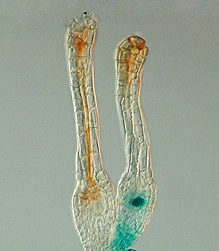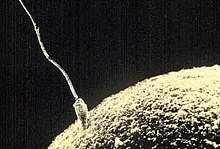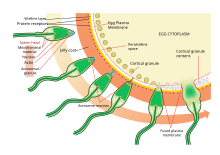
| Home | Sources Directory | News Releases | Calendar | Articles | | Contact | |
Ovum

An ovum (plural ova, from the Latin word ovum meaning egg or egg cell) is a haploid female reproductive cell or gamete. Both animals and embryophytes have ova. The term ovule is used for the young ovum of an animal, as well as the plant structure that carries the female gametophyte and egg cell and develops into a seed after fertilization. In lower plants and algae, the ovum is also often called oosphere.
Contents |
[edit] Ova production
In higher animals, ova are produced by female gonads (sexual glands) called ovaries and all of them are present at birth in mammals, and mature via oogenesis.
[edit] Human and mammal ova
In the viviparous animals (which include humans and all other placental mammals), the ovum is fertilized inside the female body, and the embryo then develops inside the uterus, receiving nutrition directly from the mother.
The ovum is one of the largest cells in the human body, typically visible to the naked eye without the aid of a microscope or other magnification device. The human ovum measures 120 –m in diameter.[1][2][3]
[edit] Protist and plant ova
In protists, fungi and many plants, such as bryophytes, ferns, and gymnosperms, ova are produced inside archegonia. Since the archegonium is a haploid structure, egg cells are produced via mitosis. The typical bryophyte archegonium consists of a long neck with a wider base containing the egg cell. Upon maturation, the neck opens to allow sperm cells to swim into the archegonium and fertilize the egg. The resulting zygote then gives rise to an embryo, which will grow out of the archegonium as a young sporophyte.
In the flowering plants, the female gametophyte, which usually gives rise to the archegonium, has been reduced to just eight cells referred to as the embryo sac inside the ovule. The gametophyte cell closest to the micropyle opening of the embryo sac develops into the egg cell. Upon pollination, a pollen tube delivers sperm into the embryo sac and one sperm nucleus fuses with the egg nucleus. The resulting zygote develops into an embryo inside the ovule. The ovule in turn develops into a seed and in many cases the plant ovary develops into a fruit to facilitate the dispersal of the seeds. Upon germination, the embryo grows into a seedling.

In the moss Physcomitrella patens, the Polycomb protein FIE is expressed in the unfertilised egg cell (Figure, right) as the blue colour after GUS staining reveals. Soon after fertilisation the FIE gene is inactivated (the blue colour is no longer visible, left) in the young embryo. [4]
[edit] Ova development in oviparous animals
In the oviparous animals (all birds, most fishes, amphibians and reptiles) the ova develop protective layers and pass through the oviduct to the outside of the body. They are fertilized by male sperm either inside the female body (as in birds), or outside (as in many fishes). After fertilization, an embryo develops, nourished by nutrients contained in the egg. It then hatches from the egg, outside the mother's body. See egg (biology) for a discussion of eggs of oviparous animals.
The egg cell's cytoplasm and mitochondria (and chloroplasts in plants) are the sole means of the egg being able to reproduce by mitosis and eventually form a blastocyst after fertilization.
[edit] Ovoviviparity
There is an intermediate form, the ovoviviparous animals: the embryo develops within and is nourished by an egg as in the oviparous case, but then it hatches inside the mother's body shortly before birth, or just after the egg leaves the mother's body. Some fish, reptiles and many invertebrates use this technique.
[edit] See also
[edit] External links
- The Ovarian Kaleidoscope Database description of 1800 genes involved in ovarian functions
[edit] References
- ^ [1]
- ^ http://www.rense.com/morgphase/sizematters.htm
- ^ http://www.helium.com/items/699545-the-largest-and-smallest-cells-in-the-human-body
- ^ Assaf Mosquna, Aviva Katz, Eva L. Decker, Stefan A. Rensing, Ralf Reski, Nir Ohad (2009): Regulation of stem cell maintenance by the Polycomb protein FIE has been conserved during land plant evolution. Development 136, 2433-2444. doi:10.1242/10.1242/dev.035048
|
SOURCES.COM is an online portal and directory for journalists, news media, researchers and anyone seeking experts, spokespersons, and reliable information resources. Use SOURCES.COM to find experts, media contacts, news releases, background information, scientists, officials, speakers, newsmakers, spokespeople, talk show guests, story ideas, research studies, databases, universities, associations and NGOs, businesses, government spokespeople. Indexing and search applications by Ulli Diemer and Chris DeFreitas.
For information about being included in SOURCES as a expert or spokesperson see the FAQ . For partnerships, content and applications, and domain name opportunities contact us.

